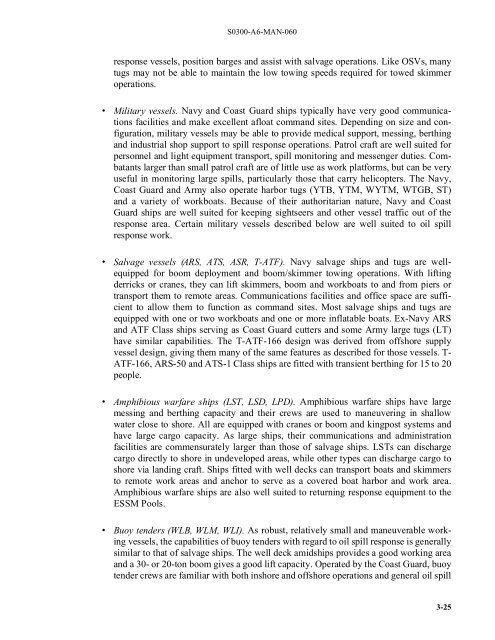U.S. Navy Ship Salvage Manual Volume 6 - Oil Spill Response
U.S. Navy Ship Salvage Manual Volume 6 - Oil Spill Response
U.S. Navy Ship Salvage Manual Volume 6 - Oil Spill Response
- No tags were found...
You also want an ePaper? Increase the reach of your titles
YUMPU automatically turns print PDFs into web optimized ePapers that Google loves.
S0300-A6-MAN-060response vessels, position barges and assist with salvage operations. Like OSVs, manytugs may not be able to maintain the low towing speeds required for towed skimmeroperations.• Military vessels. <strong>Navy</strong> and Coast Guard ships typically have very good communicationsfacilities and make excellent afloat command sites. Depending on size and configuration,military vessels may be able to provide medical support, messing, berthingand industrial shop support to spill response operations. Patrol craft are well suited forpersonnel and light equipment transport, spill monitoring and messenger duties. Combatantslarger than small patrol craft are of little use as work platforms, but can be veryuseful in monitoring large spills, particularly those that carry helicopters. The <strong>Navy</strong>,Coast Guard and Army also operate harbor tugs (YTB, YTM, WYTM, WTGB, ST)and a variety of workboats. Because of their authoritarian nature, <strong>Navy</strong> and CoastGuard ships are well suited for keeping sightseers and other vessel traffic out of theresponse area. Certain military vessels described below are well suited to oil spillresponse work.• <strong>Salvage</strong> vessels (ARS, ATS, ASR, T-ATF). <strong>Navy</strong> salvage ships and tugs are wellequippedfor boom deployment and boom/skimmer towing operations. With liftingderricks or cranes, they can lift skimmers, boom and workboats to and from piers ortransport them to remote areas. Communications facilities and office space are sufficientto allow them to function as command sites. Most salvage ships and tugs areequipped with one or two workboats and one or more inflatable boats. Ex-<strong>Navy</strong> ARSand ATF Class ships serving as Coast Guard cutters and some Army large tugs (LT)have similar capabilities. The T-ATF-166 design was derived from offshore supplyvessel design, giving them many of the same features as described for those vessels. T-ATF-166, ARS-50 and ATS-1 Class ships are fitted with transient berthing for 15 to 20people.• Amphibious warfare ships (LST, LSD, LPD). Amphibious warfare ships have largemessing and berthing capacity and their crews are used to maneuvering in shallowwater close to shore. All are equipped with cranes or boom and kingpost systems andhave large cargo capacity. As large ships, their communications and administrationfacilities are commensurately larger than those of salvage ships. LSTs can dischargecargo directly to shore in undeveloped areas, while other types can discharge cargo toshore via landing craft. <strong>Ship</strong>s fitted with well decks can transport boats and skimmersto remote work areas and anchor to serve as a covered boat harbor and work area.Amphibious warfare ships are also well suited to returning response equipment to theESSM Pools.• Buoy tenders (WLB, WLM, WLI). As robust, relatively small and maneuverable workingvessels, the capabilities of buoy tenders with regard to oil spill response is generallysimilar to that of salvage ships. The well deck amidships provides a good working areaand a 30- or 20-ton boom gives a good lift capacity. Operated by the Coast Guard, buoytender crews are familiar with both inshore and offshore operations and general oil spill3-25
















